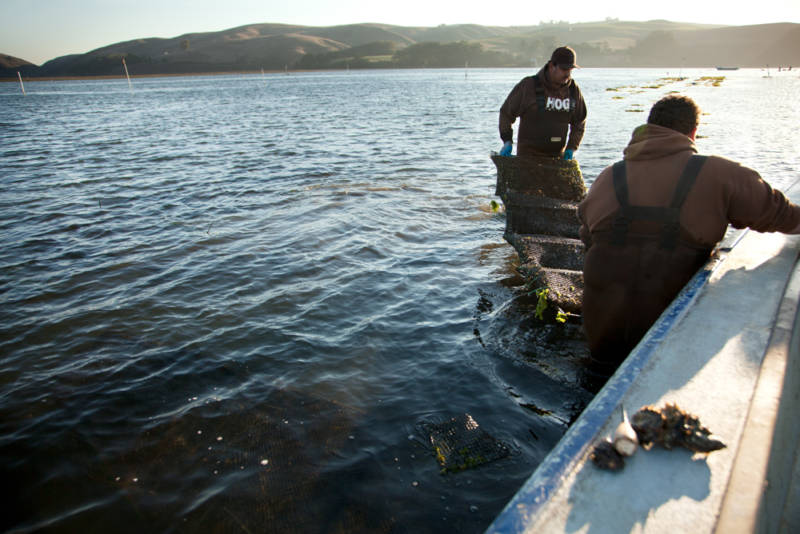“We hear a lot about ocean acidification,” Grosholz said. “We have to keep our eye on the fact that other variables that are influenced by climate change may be just as important in the future.”
‘Convergence of Stresses’
From warming water and air temperatures to ecological disruptions, California’s oyster populations face a “convergence of stresses,” Grosholz said.
Warm water holds less dissolved oxygen than cold water. In extreme cases, when the water temperatures rise too high, the oysters can suffocate. That trend is only expected to increase, as California experiences hotter summers with higher air and water temperatures, Grosholz said.
When winter storms fill estuaries with fresh water, it temporarily reduces the water’s saltiness. The rainwater upsets the oyster’s osmotic balance, Grosholz said, they need a bit of brine to survive or they stop pumping water and eating.
The bivalves can handle the rain water for a few days. “They literally clam up and don’t open at all in low salinity,” he said. “But after a week or so they have to and that’s when they die.”
While strong winter rainstorms driven by atmospheric rivers aren’t new, they are exacerbated by climate change.
In the spring and summer, wind drives deeper ocean water into estuaries and bays where the oysters live. This upwelling process, Grosholz said, is like “when you put cream in your coffee and blow across the surface, you can see cream mixing up from the bottom.”
The seawater is increasingly acidic because oceans absorb the carbon dioxide we add to the air through burning fossil fuels.
It’s especially hard for oysters to reproduce in acidic water as it can erode calcium carbonate, which they use to build their shells.
With all the seasonal issues, says Grosholz, “we’re seeing it squeeze at both ends. Climate change is reducing the critical zone where oysters do well.”
Scientists found similar results while researching oysters in the coastal waters of Washington’s Puget Sound, according to Alexandria Boehm, an environmental engineer and professor at Stanford University.
In 2016, Boehm co-lead a science panel in California that found that global carbon emissions were a major driver of ocean acidification and recommended more studies into other threats to the oysters. Subsequently, the Legislature passed a bill to support research like the new UC Davis study.
The beds of the California native Olympia oyster provide habitat for small fish and invertebrates, which in turn are prey for shorebirds, salmon, and foraging sturgeon. Grosholz’s research focused on the Olympia oyster and the non-native Pacific oyster, known for its crisp texture and mild and sweet flavor. Pacific oysters support a $25 million industry in California and are a staple in oyster shacks and seafood restaurants.
In an interview with KQED’s Michael Krasny on the program Forum, Oyster farmer Terry Sawyer talked about the study’s implications for his farm in Tomales Bay and operating a business in such a dynamic ecosystem.
“The aquaculture industry challenge we are talking about is always change,” said Sawyer, a founder of Hog Island Oyster Co. “As a business, we have to prepare.”
“The Pacific oyster is the most commonly grown species in aquaculture around the world,” he said. “This is going on here in Tomales Bay, but the ramifications are for the entire industry on the West Coast.”
Solutions and Hope
While curbing climate change will take a global effort, Grosholz research points to a number of ways that wildlife officials in California can support oyster growth.
They can divert the runoff away from oyster habitats, for example, and farmers can breed oysters to be more resilient to temperature changes in the water.
Also, there are ongoing efforts to restore native oyster populations.
In the San Francisco Bay and elsewhere, scientists and farmers construct reefs out of large mesh bags filled with discarded oyster shells. The restoration effort improves the habitat of bays and estuaries and help form more resilient shorelines.
“Oysters offer a real benefit to humans,” Grosholz said. “You see these projects actively being conducted in the San Francisco Bay, for example. That’s a reason to be hopeful about the future to me.”

